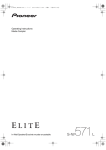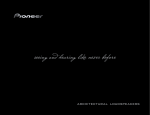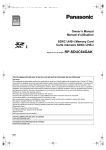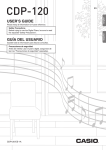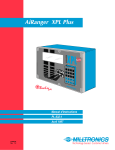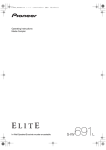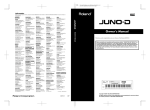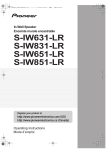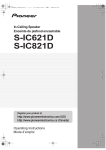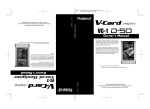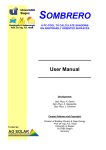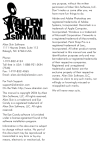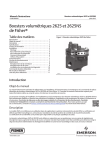Download Operating Instructions Mode d`emploi
Transcript
S-IC671_871A_SRD1377.book 1 ページ 2009年2月17日 火曜日 午後12時55分 Operating Instructions Mode d’emploi In-Ceiling Speaker/Enceinte de plafond encastrable S-IC671_871A_SRD1377.book 2 ページ 2009年2月17日 火曜日 午後12時55分 Thank you for buying this Pioneer product. Please read through these operating instructions so you will know how to operate your model properly. After you have finished reading the instructions, put them away in a safe place for future reference. Introduction This speaker system is designed for in-ceiling installation. The design features provide for a wide range of placement and listening position options. This speaker system is designed with CST (Coherent Source Transducer) technology to assure excellent sound quality. CST sound delivery is extremely smooth and coherent. All sound - direct and reflected - arrives at the listening position with matched timbre. This speaker system is also paintable so that they may be matched to your room decor. Before you start • The nominal impedance of this speaker system is 6 Ω. Connect the speaker system to an amplifier capable of driving an impedance of at least 6 Ω. This product incorporates auto-resetting overload protection technology to help avoid damage to the speakers. However, please observe the following precautions: • Do not supply amplification power to the speaker system in excess of the maximum permissible input, which could damage the speaker and cause a hazard from overheating. • If using a graphic equalizer to boost sounds in the high-frequency range, do not use excessive amplifier volume. • Do not try to force a low-powered amplifier to produce high sound levels as the amplifier’s harmonic distortion will be increased, and you may damage the speaker. Caution: installation • Pioneer is not responsible for any accidents or damage that result from improper installation, misuse, modification of the product, or natural disasters. • This speaker system must be installed by a qualified technician as it involves such tasks as selecting a location for installation, drilling holes in walls/ceiling, wiring, and painting. Have the installer carefully follow the installation instructions. • The installation technician must follow professional installation techniques to protect the speaker system against falling. • When installing the speakers, make sure that the wall/ceiling is strong enough to support the speakers. • Improper installation of the speakers could cause them to fall and cause damage or injuries to persons nearby. 2 en • Switch off and unplug your AV equipment and consult the instructions when connecting up components. Make sure you use the correct connecting cables. • Keep magnetic objects such as screwdrivers or steel parts away from the tweeter and woofer speakers. Since the speakers use strong magnets, the objects may be attracted, causing injury or damaging the diaphragm. • Do not install the speakers where they will be in direct sunlight, and avoid positioning them near heaters and air conditioners. This may cause warping and discoloration of the speaker and damage to the speakers. • This speaker system is designed for home use only. To avoid electric shock hazard, do not place them outside, or in an overly humid area. • This speaker system is heavy, and should be handled with caution by two or more people. Caution: in use • If the speakers stop emitting sound after receiving too large an input signal, turn down the volume control on the amplifier and wait a few seconds. The protection feature will be reset automatically. For U.S. model WARNING: Handling the cord on this product or cords associated with accessories sold with the product will expose you to chemicals listed on proposition 65 known to the State of California and other governmental entities to cause cancer and birth defect or other reproductive harm. Wash hands after handling D36-P4_A_En S-IC671_871A_SRD1377.book 3 ページ 2009年2月17日 火曜日 午後12時55分 What’s in the box Grille x 1 Grille removal tool x 1 Template x 1 • Keep the speaker system at least 50 cm (20 in.) away from the edge of the wall or ceiling. If this is not possible, adjust the sound balance by using the speakers’ treble or bass level controls. English Paint mask x 1 (Transparent) • Place the left and right speakers equal distances from your listening position for good stereo imaging. Use speaker cables of the equal length for each speaker. • This speaker system is not magnetically shielded. It should therefore not be placed near TVs or monitors that are sensitive to magnetic fields, as the interaction of magnetic materials can cause distortion of the colors on your TV screen. Magnetic storage media (such as floppy discs and tape or video cassettes) should also not be kept close to this speaker system. For the installer Operating instructions (This document) Butyl rubber tapes x 8 • Give adequate consideration to the location of installation before the setup of this speaker system. • Check the walls/ceiling to see if they are strong enough to withstand the weight of the speaker system. Installation • Installation is possible on ceiling from 12.5 mm (1/2 in.) to 25 mm (1 in.) thick. Standard surround setup Sounds reproduced through speaker systems are easily affected in subtle ways by the conditions in the listening space. To assure optimum performance from this speaker system, give adequate consideration to the installation location before setup. Use the graphic below as a guide to determine optimal speaker placement. Front left Center • Check the walls/ceiling to confirm there is no wiring, plumbing, beams, studs or air conditioning systems that may interfere with installation. • Pioneer disclaims any liability whatsoever for damage resulting from assembly, improper mounting, insufficient reinforcement, misuse of the product, acts of nature, etc. Front right Listening position Rear left Rear right 3 en S-IC671_871A_SRD1377.book 4 ページ 2009年2月17日 火曜日 午後12時55分 Painting the speakers How to install While the speaker and grille can be painted after it is installed, painting it beforehand is much easier. Make sure you have read and understood all the information above, For the installer on page 3 and Before installing above. It is recommended to use spray paint, as brushed paint may clog the holes in the grille and reduce the sound quality significantly. 1 Remove the fabric scrim from the inside of the grille. Carefully peel off the fabric scrim and lay it down flat so as not to get it wrinkled. 2 Use the supplied paint mask to cover the speaker. If you don’t have the paint mask, use paper and masking tape. 1 Once you have decided on the installation location, prepare the supplied template. Cut out the inside of the template along the dotted line and discard the inner section. 2 Attach the template (outer section) to the wall/ ceiling using tape. Make sure the template is aligned properly. 3 Trace a line onto the wall/ceiling, following the inner perimeter of the template. 3 Paint the speaker and grille the desired color. As previously mentioned, it is strongly recommended that you paint before installation and that you use spray paint. 4 After the speaker and grille have dried completely, remove the paint mask and carefully replace the fabric scrim on the back of the grille. Before installing • Before installing the speakers, run the speaker cables to the installation location. • To maximize sound quality, choose the correct speaker gauge cables from the table below. If the resistance of the speaker cable is too high, the signal will be attenuated and the speakers’ frequency response will be degraded. AWG feet mm2 meters 16 or 14 less than 25 1.5 to 2.5 less than 8 14 or 12 25 to 50 2.5 to 4 8 to 16 12 or 10 50 to 75 4 to 6 16 to 24 10 more than 75 6 more than 24 4 Cut a hole where you have drawn the outline. Be careful when cutting the hole, and use a proper cutting tool. 5 Pull the speaker cable through the hole that has been opened. Be careful not to apply to much force when pulling on the speaker cable or bend the cable at sharp angles. 6 Connect the cable wire to the speaker as shown below. When connecting the speakers, be careful not to touch the diaphragms of the drivers. Twist and pull off the protective shields on each wire. 10 mm (0.4 in.) Insert the speaker cable wires into the holes while pressing down on the terminal posts on the speaker, and then release the terminal posts. For input terminal polarity, red is positive (+) and black is negative (–). • After connecting the wires, pull lightly on them to make sure that the ends of the wires are securely connected to the terminals. Poor connections can create noise and interruptions in the sound. 4 en S-IC671_871A_SRD1377.book 5 ページ 2009年2月17日 火曜日 午後12時55分 • If the wires are pulled out of the terminal posts and the conductors come into contact with each other or surrounding devices, an excessive additional load may be placed on the amplifier. This may cause the amplifier to stop functioning, and may even cause it damage. CAUTION These speaker terminals carry HAZARDOUS LIVE voltage. To prevent the risk of electric shock when connecting or disconnecting the speaker cables, disconnect the power cord before touching any D3-4-2-2-3_A_En uninsulated parts. 7 Where available, use the fixing bracket located on the back of the speaker system and attach a reinforced wire, such as stainless steel wire rope, to the studs or beams of the walls/ceiling. • A Phillips screwdriver is required for loosening them. • When using electric screwdrivers, first find out the minimum torque required for the installation of the speaker system. Begin by setting the electric screwdriver to its minimum torque and gradually raise the torque until the screw starts to rotate. Check what torque setting you are on at this point (this will be the minimum torque required for the setup). After confirming the torque, return the rotating clamps toward the inside by reversing the direction of rotation of the screws. When doing this, take care that the screws do not come all the way out. English • Be careful to observe the correct polarity of the connections between the cables and the speaker. If the polarity (+, –) of one of the speakers (left or right) is reversed the stereo image will be severely degraded. 9 Place the speaker into the hole you have cut. Make sure the rotating clamps are turned inward. Rotating clamp Speaker frame Screw • It is strongly recommended that you take double safe precautions to prevent the speaker from falling by accident. Stud/beam Reinforced wire (not supplied) 10 Attach the speaker frame to the wall/ceiling, and tighten the screws lightly (temporary attachment). At this point the rotating clamp will rotate so that the rotating clamp and frame are clamped on to the wall/ ceiling. Gently try pulling the speaker forward and check that all of the rotating clamps have rotated outwards and are lightly clamping to the wall/ceiling. 11 Adjust the mounting orientation to point the CST toward the listening position. Fixing bracket • Put the reinforced wire through the fixing bracket and attach to the studs or beams. Make sure the stud/ beam that you are attaching it to is strong enough to support the weight of the speaker system. 8 Place sound-absorbing material (such as fiberglass) around the speakers as necessary to improve sound quality. Use only sound-absorbing materials that comply with regional safety regulations. 12 Tighten the screws firmly using no more than the maximum torque specified. Allowable maximum torque: 1.0 N⋅m • Screwing them in too tightly could break the rotating clamps, twist the frames, damage the walls/ceilings and make it difficult to attach the grille. 13 Make sure that the screws are not crooked and that there is no gap between the wall/ceiling and frame. 5 en S-IC671_871A_SRD1377.book 6 ページ 2009年2月17日 火曜日 午後12時55分 14 Adjust the settings of the treble and/or bass controls as necessary. • Treble adjustment Connections The standard setting is 0. The treble switch located in the front of the speaker has three positions to choose from, +/0/–. • Bass adjustment The standard setting is 0. The bass switch located in the front of the speaker has two positions to choose from, 0/–. 15 Attach the butyl rubber tapes on the inside of the grille. Attach the eight butyl rubber tapes to each grille, lining up the butyl rubber tapes to the marks on the inside of the grille. Then peel off the protective paper. 16 Attach the grille to the speaker. The grille is designed with a specific mounting orientation. Gently push the grille onto the speaker, lining up the one section of the edge of the grille to the groove in the speaker. Then line up the entire grille to the groove in the speaker and attach the grille by pressing in all around the edge. Orientate the grille so that the notch is positioned adjacent to the ELITE logo. Make sure to press on the edges. Pressing on the middle of the grille will cause it to be deformed. • Once you have pushed it in, make sure you press it firmly against the speaker so that the grille doesn’t fall off and cause an accident. • To remove the grille, use the supplied tool to hook into the holes located near the edges and pull the grille out. When doing this, make sure to pull the edges out evenly. Forcing the grille out from one edge alone will cause the grille to be deformed. 6 en Connecting to an amplifier Make sure you have read the connection instructions in the manual supplied with the amplifier and that all equipment is turned off before making any connections. • When using a set of speakers connected to an amplifier, you won’t be able to obtain the correct stereo effect if the polarity (+, –) of one of the speakers (left or right) is reversed. S-IC671_871A_SRD1377.book 7 ページ 2009年2月17日 火曜日 午後12時55分 Additional Information Accessories Cleaning the speaker Use a dust brush to wipe off dust and dirt. Specifications Speaker system S-IC671A Speaker units . . . . . . . . . . . . . . . . . . . . . . . . . . .In-ceiling type Configuration . . . . . . . . . . . . . . . . . . . . 16 cm (6 1/2 in.) 2-way CST: Woofer/Tweeter . . . . . . . . . . . . . . .16 cm (6 1/2 in.) Aramid fiber cone type/ 3.8 cm (1 1/2 in.) Titanium dome/Aluminum cone type Impedance. . . . . . . . . . . . . . . . . . . . . . . . . . . . . . . . . . . . . . 6 Ω Frequency response . . . . . . . . . . . . . . . . . . . . 32 Hz to 40 kHz Sensitivity. . . . . . . . . . . . . . . . . . . . . . . . . . . . . . . 88 dB (2.83 V) Maximum input power . . . . . . . . . . . . . . . . . . . . . . . . . . 130 W Crossover frequency . . . . . . . . . . . . . . . . . . . . . . . . . . . 2.2 kHz External dimensions . . . . . . . . . . . . φ 294 mm x 134 mm (D) English Never use furniture wax, cleaners, thinners, benzine, insecticide sprays or other chemicals on or near the speakers, since these will corrode the surfaces. Paint mask . . . . . . . . . . . . . . . . . . . . . . . . . . . . . . . . . . . . . . . . 1 Grille . . . . . . . . . . . . . . . . . . . . . . . . . . . . . . . . . . . . . . . . . . . . . 1 Template . . . . . . . . . . . . . . . . . . . . . . . . . . . . . . . . . . . . . . . . . . 1 Butyl rubber tapes . . . . . . . . . . . . . . . . . . . . . . . . . . . . . . . . . . 8 Grille removal tool . . . . . . . . . . . . . . . . . . . . . . . . . . . . . . . . . . 1 Operating instructions (This document) • Specifications and design subject to modification without notice. • CST (Coherent Source Transducer) is a threedimensionally-aligned sound source for the tweeter and woofer, allowing the sound directivity to be precisely controlled at all frequency. is a trademark placed on a product with Pioneer’s Phase Control technology. This technology enables high-grade sound reproduction through each component by improving overall phase matching. φ 11 9/16 in. x 5 1/4 (D) in. Weight . . . . . . . . . . . . . . . . . . . . . . . . . . . . . . 3.1 kg/6 lbs 13 oz S-IC871A Speaker units . . . . . . . . . . . . . . . . . . . . . . . . . . .In-ceiling type Configuration . . . . . . . . . . . . . . . . . . . . . . .20 cm (8 in.) 2-way CST: Woofer/Tweeter . . . . . . . . . . . . . . . . . 20 cm (8 in.) Aramid fiber cone type/ 3.8 cm (1 1/2 in.) Titanium dome/Aluminum cone type Impedance. . . . . . . . . . . . . . . . . . . . . . . . . . . . . . . . . . . . . . 6 Ω Frequency response . . . . . . . . . . . . . . . . . . . . 28 Hz to 40 kHz Sensitivity. . . . . . . . . . . . . . . . . . . . . . . . . . . . . . . 89 dB (2.83 V) Maximum input power . . . . . . . . . . . . . . . . . . . . . . . . . . 130 W Crossover frequency . . . . . . . . . . . . . . . . . . . . . . . . . . . 2.0 kHz External dimensions . . . . . . . . . . . . φ 294 mm x 135 mm (D) φ 11 9/16 in. x 5 5/16 (D) in. Weight . . . . . . . . . . . . . . . . . . . . . . . . . . . . . . 3.1 kg/6 lbs 13 oz 7 en S-IC671_871A_SRD1377.book 8 ページ 2009年2月17日 火曜日 午後12時55分 We Want You Listening For A Lifetime Selecting fine audio equipment such as the unit you’ve just purchased is only the start of your musical enjoyment. Now it’s time to consider how you can maximize the fun and excitement your equipment offers. This manufacturer and the Electronic Industries Association’s Consumer Electronics Group want you to get the most out of your equipment by playing it at a safe level. One that lets the sound come through loud and clear without annoying blaring or distortion-and, most importantly, without affecting your sensitive hearing. Sound can be deceiving. Over time your hearing “comfort level” adapts to higher volumes of sound. So what sounds “normal” can actually be loud and harmful to your hearing. Guard against this by setting your equipment at a safe level BEFORE your hearing adapts. Used wisely, your new sound equipment will provide a lifetime of fun and enjoyment. Since hearing damage from loud noise is often undetectable until it is too late, this manufacturer and the Electronic Industries Association’s Consumer Electronics Group recommend you avoid prolonged exposure to excessive noise. This list of sound levels is included for your protection. Decibel Level Example 30 40 50 60 70 80 Quiet library, soft whispers Living room, refrigerator, bedroom away from traffic Light traffic, normal conversation, quiet office Air conditioner at 20 feet, sewing machine Vacuum cleaner, hair dryer, noisy restaurant Average city traffic, garbage disposals, alarm clock at two feet. THE FOLLOWING NOISES CAN BE DANGEROUS UNDER CONSTANT EXPOSURE To establish a safe level: • Start your volume control at a low setting. • Slowly increase the sound until you can hear it comfortably and clearly, and without distortion. 90 Subway, motorcycle, truck traffic, lawn mower 100 Garbage truck, chain saw, pneumatic drill 120 Rock band concert in front of speakers, thunderclap 140 Gunshot blast, jet plane 180 Rocket launching pad Once you have established a comfortable sound level: • Set the dial and leave it there. Information courtesy of the Deafness Research Foundation. Taking a minute to do this now will help to prevent hearing damage or loss in the future. After all, we want you listening for a lifetime. S001_En Published by Pioneer Corporation. Copyright © 2009 Pioneer Corporation. All rights reserved. 8 en S-IC671_871A_SRD1377.book 9 ページ 2009年2月17日 火曜日 午後12時55分 English 9 en S-IC671_871A_SRD1377_fr.book 2 ページ 2009年2月17日 火曜日 午後1時21分 Nous vous remercions d’avoir acheté ce produit Pioneer. Veuillez lire attentivement ce mode d’emploi de manière à pouvoir utiliser votre modèle correctement. Après avoir lu ces explications, conservez-les en lieu sûr pour éventuellement les consulter plus tard. Introduction Cette enceinte acoustique est conçue en vue d’une installation au plafond. Les particularités du design permettent de répondre à une large gamme de dispositions et de positions d’écoute. Cette enceinte est conçue en faisant appel à la technologie CST (Transducteur de Source Cohérent) qui garantit une excellente qualité sonore. La restitution sonore par CST est extrêmement souple et cohérente. Tous les sons, qu’ils soient directs ou réfléchis, arrivent à la position d’écoute avec un timbre adéquat. Cette enceinte acoustique peut être peinte, ce qui vous permet de mieux l’intégrer à votre décoration intérieure. Avant de commencer • L’impédance nominale de ces enceintes acoustiques est de 6 Ω. Raccordez l’enceinte acoustique à une amplificateur capable de convenir à une impédance d’au moins 6 Ω. • Une installation inadéquate de l’enceinte pourrait être à l’origine de sa chute qui causerait des dégâts voire des blessures. • Mettez votre appareil audiovisuel hors tension et débranchez-le, puis consultez le mode d’emploi avant de brancher des composants. Prenez soin d’utiliser correctement les câbles de raccordement. • Tenez des objets magnétisés, tels que tournevis ou pièces en acier, à l’écart des haut-parleurs aigus et graves. Comme ces haut-parleurs utilisent des aimants puissants, ces objets pourraient y être attirés, provoquant des dégâts aux haut-parleurs ou endommageant leur diaphragme. • N’installez pas les enceintes en plein soleil et évitez de les placer près d’appareils de chauffage ou de climatiseurs. Ceci pourrait gondoler et décolorer le coffret des enceintes et endommager leurs hautparleurs. • Ne fournissez pas aux enceintes une puissance d’amplification supérieure à l’entrée maximale admissible, afin de ne pas endommager les hautparleurs et d’éviter tout danger par surchauffe. • Cette enceinte acoustique est conçue en vue d’une utilisation intérieure uniquement. Pour éviter des décharges électriques, ne les placez pas à l’extérieur ou dans un endroit très humide. • Si vous utilisez un égaliseur graphique pour accentuer les sons dans la plage des hautes fréquences, n’élevez pas trop le volume de l’amplificateur. • Cette enceinte acoustique est pesante et elle doit donc être manipulée prudemment par deux personnes au moins. Attention : installation • Pioneer n’assume aucune responsabilité en cas d’accidents ou de dégâts résultant d’une installation inappropriée, d’une erreur d’utilisation, d’une altération du produit et/ou de catastrophes naturelles. • L’installation de cette enceinte acoustique doit être confiée à un technicien qualifié, car elle nécessite des tâches comme la sélection d’un endroit d’installation, le forage de trous dans des murs/ plafond, le câblage et la peinture de certains éléments. Demandez à l’installateur de respecter fidèlement les instructions suivantes. fr • A l’installation de l’enceinte, assurez-vous que le mur/plafond est assez résistant pour la supporter. Pour éviter d’endommager les haut-parleurs, cet appareil incorpore une technologie de remise à zéro automatique comme protection contre la surcharge. Toutefois, respectez les instructions suivantes : • N’essayez pas de pousser un amplificateur de faible puissance à produire de hauts niveaux sonores, car la distorsion harmonique de l’amplificateur en serait accentuée et vous pourriez endommager les haut-parleurs. 2 • Le technicien doit respecter les techniques d’installation professionnelles pour éviter la chute des enceintes acoustiques. Attention : à l’emploi • Si les haut-parleurs cessent d’émettre des sons après la réception d’un signal d’entrée trop puissant, réduisez le volume sur l’amplificateur et attendez quelques secondes. Cette fonction de protection sera automatiquement réinitialisée. S-IC671_871A_SRD1377_fr.book 3 ページ 2009年2月17日 火曜日 午後1時21分 Contenu de l’emballage Masque de peinture x 1 Grille x 1 (Transparent) Gabarit x 1 • Placez l’enceinte à 50 cm au moins du bord du mur ou du plafond. Si ce n’est pas possible, ajustez la balance sonore au moyen de la commande des aigus et des graves des enceintes. • Ces enceintes acoustiques ne sont pas pourvues d’un blindage magnétique. Elles ne doivent donc pas être placées près de téléviseurs ou de moniteurs sensibles aux champs magnétiques, car l’interaction des matériaux magnétiques peut provoquer une distorsion des couleurs sur l’écran du téléviseur. Des supports de mémorisation magnétique (tels que disquettes, cassettes audio ou vidéo) doivent aussi être tenus à l’écart de cette enceinte acoustique. Français Outil de retrait de grille x1 • Pour obtenir une bonne image stéréo, placez les enceintes gauche et droite à distance égale de la position d’écoute. Utilisez des câbles d’enceinte de longueur égale pour chaque enceinte. A l’intention de l’installateur Mode d’emploi (Ce document) Bandes en caoutchouc butyle x 8 • Examinez les murs/plafond pour voir s’ils sont assez solides pour résister au poids de l’enceinte. Installation • Une installation est possible sur des plafonds de 12,5 mm à 25 mm d’épaisseur. Configuration d’ambiance standard Les sons reproduits par les enceintes acoustiques sont facilement affectés de manière subtile par les conditions du local d’écoute. Pour obtenir des performances optimales de cette enceinte, prenez en considération l’emplacement d’installation avant la configuration. Utilisez le graphique suivant comme guide pour déterminer l’emplacement idéal des enceintes. Avant gauche • Réfléchissez bien à l’emplacement d’installation avant de configurer cette enceinte acoustique. Centre • Examinez les murs/plafonds pour vous assurer qu’ils ne contiennent pas de fils, tuyaux, poutres, montants ou canalisations de climatisation qui pourraient gêner l’installation. • Pioneer rejette toute responsabilité en cas de dégâts causés par un assemblage et un montage inadéquats, un renforcement insuffisant, une erreur d’utilisation, des catastrophes naturelles, etc. Avant droit Position d’écoute Arrière gauche Arrière droit 3 fr S-IC671_871A_SRD1377_fr.book 4 ページ 2009年2月17日 火曜日 午後1時21分 Peinture des enceintes Méthode d’installation Bien que l’enceinte et la grille puissent être peintes après leur installation, il est plus facile de le faire avant leur installation. Veuillez lire de manière à les comprendre toutes les informations ci-avant sous : A l’intention de l’installateur la page 3 et Avant l’installation ci-dessus. Il est conseillé d’utiliser de la peinture par pulvérisation, car une peinture au pinceau bouchera les orifices de la grille et réduira considérablement la qualité des sons. 1 Enlevez le diffuseur en tissu par l’intérieur de la grille. Décollez délicatement le diffuseur en tissu et posez-le à plat de sorte qu’il ne fasse pas de pli. 2 Utilisez le masque de peinture fourni pour recouvrir l’enceinte. Si vous n’avez pas de masque de peinture, utilisez un papier ou une bande de masquage. 1 Lorsque vous avez décidé l’endroit d’installation, préparez le gabarit fourni. Découpez l’intérieur du gabarit le long de la ligne pointillée et débarrassez-vous de la section intérieure. 2 Fixez le gabarit (section externe) sur le mur/plafond au moyen de ruban adhésif. Assurez-vous que le gabarit est correctement aligné. 3 Tracez une ligne sur le mur/plafond en suivant le périmètre interne du gabarit. 3 Appliquez la couleur souhaitée sur l’enceinte et la grille. Comme déjà mentionné, il est conseillé de peindre avant l’installation et d’utiliser une peinture par pulvérisation. 4 Une fois que l’enceinte et la grille sont complètement sèches, retirez le masque de peinture et replacez délicatement le diffuseur en tissu sur la grille. 4 Découpez un trou à l’endroit ou vous avez tracé le contour. Agissez avec prudence pour découper le trou et utilisez un outil approprié. Avant l’installation • Avant l’installation des enceintes, cheminez les câbles d’enceinte vers l’endroit d’installation. • Pour optimiser la qualité sonore, choisissez des câbles d’enceinte du calibre correct en consultant le tableau suivant. Si la résistance du câble d’enceinte est trop élevée, le signal sera atténué et la réponse en fréquence des enceintes sera amoindrie. mm2 mètres 1,5 à 2,5 moins de 8 2,5 à 4 8 à 16 4à6 16 à 24 6 plus de 24 5 Faites passer le câble d’enceinte par le trou qui a été découpé. Veillez à ne pas tirer fortement sur le câble d’enceinte et à ne pas le plier à un angle aigu. 6 Connectez le câble d’enceinte sur l’enceinte comme illustré ci-après. Lors du branchement des enceintes, veillez à ne pas toucher le diaphragme des haut-parleurs. Torsadez et enlevez la gaine protectrice au bout de chaque fil. 10 mm Insérez les fils du câble d’enceinte dans l’orifice des bornes en appuyant sur la borne prévue sur l’enceinte, puis en la relâchant pour immobiliser le fil. En ce qui concerne les polarités des bornes, la rouge est positive (+) et la noire est négative (–). 4 fr • Après avoir branché les fils, tirez légèrement sur ceux-ci pour vous assurer que leur extrémité est parfaitement immobilisée sur les bornes. De mauvaises connexions sont la source de parasites, voire d’interruptions des sons. S-IC671_871A_SRD1377_fr.book 5 ページ 2009年2月17日 火曜日 午後1時21分 • Si les fils des câbles d’enceinte ressortent des bornes et qu’un contact s’établit entre eux ou avec un dispositif métallique voisin, l’amplificateur risque de subir une charge anormale. Ceci peut provoquer une interruption de l’amplificateur, voire endommager celui-ci. 9 Placez l’enceinte dans l’orifice que vous avez découpé. Assurez-vous que les brides rotatives sont tournées vers l’intérieur. • Veillez à respecter la polarité correcte des connexions entre les câbles et les enceintes. Si la polarité (+, –) d’une des enceintes (gauche ou droite) est inversée, l’image stéréo sera sérieusement dégradée. • Avant d’utiliser des tournevis électriques, vérifiez au préalable le couple minimum requis pour l’installation des enceintes. Commencez par régler le tournevis électrique à son couple minimal et augmentez progressivement le couple jusqu’à ce que le tournevis commence à tourner. Vérifiez le réglage du couple à ce stade (ceci sera le couple minimal requis pour la configuration). Après avoir confirmé le couple, ramenez les brides rotatives vers l’intérieur en inversant le sens de la rotation de vis. A ce stade, assurez-vous que les vis ne ressortent pas complètement. ATTENTION Bride rotative 7 Quand c’est possible, utilisez l’applique de fixation prévue à l’arrière de l’enceinte et fixez un cordage renforcé, tel qu’un cordon à fils d’acier inoxydable, à des montants ou des poutres sur les murs/plafond. Français Les bornes des haut-parleurs sont sous une tension ACTIVE DANGEREUSE. Pour éviter tout risque de décharge électrique lors du branchement et du débranchement des câbles de haut-parleur, débranchez le cordon d’alimentation avant de toucher des parties D3-4-2-2-3_A_Fr non isolées. • Un tournevis à pointe cruciforme est nécessaire pour les desserrer. Collier d’enceinte Vis Attention • Il est vivement conseillé de prendre de sérieuses précautions pour éviter une chute accidentelle des enceintes. Montant/poutre Cordage renforcé (non fourni) 10 Fixez le collier d’enceinte sur le mur ou le plafond, puis serrez légèrement les vis (fixation temporaire). A ce stade, la bride rotative tournera de sorte que celle-ci et le collier soient immobilisés sur le mur ou au plafond. Tirez délicatement l’enceinte vers l’avant pour vérifier que toutes les brides rotatives sont tournées vers l’extérieur et qu’elles sont légèrement fixées sur le mur ou le plafond. Applique de fixation • Passez le cordage renforcé par l’applique de fixation et fixez-le sur des montants ou des poutres. Assurezvous que le montant ou la poutre est suffisamment résistant pour supporter le poids de l’enceinte. 8 Au besoin, placez un matériau isolant, tel que de la fibre de verre, autour des enceintes pour améliorer la qualité du son. Utilisez uniquement un matériau isolant qui respecte les règlements régionaux en matière de sécurité. 11 Ajustez l’orientation du montage pour diriger le tansducteur CST vers la position d’écoute. 12 Serrez fermement les vis en respectant le couple maximal spécifié. Couple maximum autorisé : 1.0 N⋅m Attention • Un serrage excessif pourrait briser les brides rotatives, tordre les colliers d’enceinte, endommager les murs ou le plafond et rendre difficile la fixation de la grille. 13 Assurez-vous que les vis ne sont pas inclinées et qu’il n’y a pas d’espace entre le mur/plafond et le collier. 5 fr S-IC671_871A_SRD1377_fr.book 6 ページ 2009年2月17日 火曜日 午後1時21分 14 Effectuez les réglages des commandes des aigus et/ ou des graves selon les besoins. • Réglage des aigus Connexions Le réglage standard est 0. Le commutateur des aigus prévu sur l’avant de l’enceinte a trois positions au choix : +/0/–. • Règlage des graves Le réglage standard est 0. Le commutateur des graves prévu sur l’avant de l’enceinte a deux positions au choix : 0/–. 15 Fixez la bande en caoutchouc butyle sur l’intérieur de la grille. Fixez les huit bandes de caoutchouc butyle sur chaque grille en alignant les bandes sur l’intérieur de la grille. Décollez ensuite le papier de protection. 16 Fixez la grille sur l’enceinte. La grille doit être montrée dans un sens seulement. Insérez délicatement la grille sur l’enceinte, en alignant une section du bord de la grille sur la rainure de l’enceinte. Alignez ensuite toute la grille avec la rainure de l’enceinte et fixez la grille en poussant tout autour du bord. Orientez la grille de sorte que l’encoche soit positionnée à côté du logo ELITE. Veillez à pousser sur les bords. Une pression au milieu de la grille pourrait la déformer. • Après avoir enfoncé la grille, assurez-vous qu’elle est fermement maintenue contre l’enceinte et qu’elle ne risque donc pas de tomber. • Pour retirer la grille, servez-vous de l’outil fourni pour accrocher les orifices prévus près des bords et détacher ainsi la grille. A ce moment, prenez soin de tirer les bords d’une manière égale. La grille pourrait être déformée si vous forcez son retrait par un bord. 6 fr Branchement à un amplificateur Veillez à lire toutes les instructions relatives aux connexions dans le mode d’emploi (fourni avec l’amplificateur) et à ce que tous les équipements soient hors tension avant d’effectuer les branchements. • A l’emploi d’un jeu d’enceintes raccordé à un amplificateur, si la polarité (+, –) d’une des enceintes acoustiques (gauche ou droite) est inversée, vous n’obtiendrez pas un effet stéréophonique normal. S-IC671_871A_SRD1377_fr.book 7 ページ 2009年2月17日 火曜日 午後1時21分 Information complémentaire Entretien de l’enceinte Servez-vous d’une brosse douce pour enlever la poussière et la saleté. N’employez jamais de cire pour meubles, détergent, diluant, benzine, insecticide en atomiseur et autre produit chimique sur ou à proximité des enceintes, car cela endommagerait leurs surfaces. Enceinte acoustique S-IC671A Enceintes . . . . . . . . . . . . . . . . . . . . . Type encastré au plafond Configuration . . . . . . . . . . . . . . . . . . . . . . . . . . 16 cm, 2 voies CST : Woofer/Tweeter . . . . . . . . . . . . . Type à cône de fibres aramides de 16 cm/ Type à dôme de titane/cône d’aluminium de 3,8 cm Impédance. . . . . . . . . . . . . . . . . . . . . . . . . . . . . . . . . . . . . . 6 Ω Réponse de fréquence . . . . . . . . . . . . . . . . . . . 32 Hz à 40 kHz Sensibilité . . . . . . . . . . . . . . . . . . . . . . . . . . . . . . 88 dB (2,83 V) Puissance d’entrée maximum. . . . . . . . . . . . . . . . . . . . 130 W Fréquence de recouvrement . . . . . . . . . . . . . . . . . . . . 2,2 kHz Dimensions extérieures . . . . . . . . . . φ 294 mm x 134 (P) mm Poids . . . . . . . . . . . . . . . . . . . . . . . . . . . . . . . . . . . . . . . . 3,1 kg Masque de peinture . . . . . . . . . . . . . . . . . . . . . . . . . . . . . . . . 1 Grille . . . . . . . . . . . . . . . . . . . . . . . . . . . . . . . . . . . . . . . . . . . . . 1 Gabarit . . . . . . . . . . . . . . . . . . . . . . . . . . . . . . . . . . . . . . . . . . . 1 Bandes en caoutchouc butyle . . . . . . . . . . . . . . . . . . . . . . . . 8 Outil de retrait de grille . . . . . . . . . . . . . . . . . . . . . . . . . . . . . . 1 Mode d’emploi (Ce document) Remarque • Spécifications et design sous réserve de modifications sans préavis. • La technologie CST (Transducteur de Source Cohérent) a une source sonore alignée en trois dimension pour le tweeter et le woofer, ce qui permet de contrôler avec prévision la directivité sonore à toutes les fréquences. est une marque de commerce, appliquée sur un appareil doté de la technologie “Phase Control” de Pioneer. Cette technologie autorise une reproduction sonore de haut niveau par chaque composant grâce à une amélioration de la synchronisation d’ensemble des phases. Français Fiche technique Accessoires Publication de Pioneer Corporation. © 2009 Pioneer Corporation. Tous droits de reproduction et de traduction réservés. S-IC871A Enceintes . . . . . . . . . . . . . . . . . . . . . Type encastré au plafond Configuration . . . . . . . . . . . . . . . . . . . . . . . . . . 20 cm, 2 voies CST : Woofer/Tweeter . . . . . . . . . . . . . Type à cône de fibres aramides de 20 cm/ Type à dôme de titane/cône d’aluminium de 3,8 cm Impédance. . . . . . . . . . . . . . . . . . . . . . . . . . . . . . . . . . . . . . 6 Ω Réponse de fréquence . . . . . . . . . . . . . . . . . . . 28 Hz à 40 kHz Sensibilité . . . . . . . . . . . . . . . . . . . . . . . . . . . . . . 89 dB (2,83 V) Puissance d’entrée maximum. . . . . . . . . . . . . . . . . . . . 130 W Fréquence de recouvrement . . . . . . . . . . . . . . . . . . . . 2,0 kHz Dimensions extérieures . . . . . . . . . . φ 294 mm x 135 (P) mm Poids . . . . . . . . . . . . . . . . . . . . . . . . . . . . . . . . . . . . . . . . 3,1 kg 7 fr Should this product require service in the U.S.A. and you wish to locate the nearest Pioneer Authorized Independent Service Company, or if you wish to purchase replacement parts, operating instructions, service manuals, or accessories, please call the number shown below. Si ce produit doit être réparé au Canada, veuillez vous adresser à un distributeur autorisé Pioneer du Canada pour obtenir le nom du Centre de Service Autorisé Pioneer le plus près de chez-vous. Vous pouvez aussi contacter le Service à la clientèle de Pioneer: Pioneer Électroniques du Canada, Inc. Service Clientèle 300, Allstate Parkway, Markham, Ontario L3R 0P2 1-877-283-5901 905-479-4411 1–800–421–1404 Please do not ship your product to Pioneer without first calling the Customer Support at the above listed number for assistance. Pioneer Electronics Service, Inc. P.O. BOX 1760, Long Beach, CA 90801-1760, U.S.A. Pour obtenir des renseignements sur la garantie, veuillez vous reporter au feuillet sur la garantie restreinte qui accompagne le produit. S018_C_EF For warranty information please see the Limited Warranty sheet included with your product. Should this product require service in Canada, please contact a Pioneer Canadian Authorized Dealer to locate the nearest Pioneer Authorized Service Company in Canada. Alternatively, please contact the Customer Satisfaction Department at the following address: Pioneer Electronics of Canada, Inc. Customer Satisfaction Department 300 Allstate Parkway, Markham, Ontario L3R 0P2 1-877-283-5901 905-479-4411 For warranty information please see the Limited Warranty sheet included with your product. Register Your Product on http://www.pioneerelectronics.com (US) http://www.pioneerelectronics.ca (Canada) Enregistrez votre produit sur : http://www.pioneerelectronics.com (US) http://www.pioneerelectronics.ca (Canada) PIONEER CORPORATION 4-1, Meguro 1-Chome, Meguro-ku, Tokyo 153-8654, Japan PIONEER ELECTRONICS (USA) INC. P.O. BOX 1540, Long Beach, California 90801-1540, U.S.A. TEL: (800) 421-1404 PIONEER ELECTRONICS OF CANADA, INC. 300 Allstate Parkway, Markham, Ontario L3R 0P2, Canada TEL: 1-877-283-5901, 905-479-4411 PIONEER EUROPE NV Haven 1087, Keetberglaan 1, B-9120 Melsele, Belgium TEL: 03/570.05.11 PIONEER ELECTRONICS ASIACENTRE PTE. LTD. 253 Alexandra Road, #04-01, Singapore 159936 TEL: 65-6472-7555 PIONEER ELECTRONICS AUSTRALIA PTY. LTD. 178-184 Boundary Road, Braeside, Victoria 3195, Australia, TEL: (03) 9586-6300 PIONEER ELECTRONICS DE MEXICO S.A. DE C.V. Blvd.Manuel Avila Camacho 138 10 piso Col.Lomas de Chapultepec, Mexico,D. F. 11000 TEL: 55-9178-427 0 K002_B_En Published by Pioneer Corporation. Copyright © 2009 Pioneer Corporation. All rights reserved. Publication de Pioneer Corporation. © 2009 Pioneer Corporation. Tous droits de reproduction et de traduction réservés. <SRD6121-A> Printed in China Imprimé en Chine
















